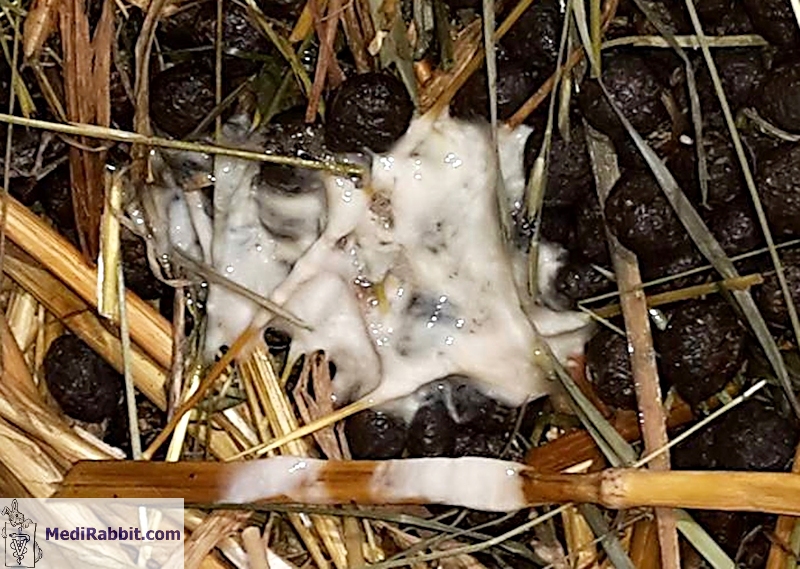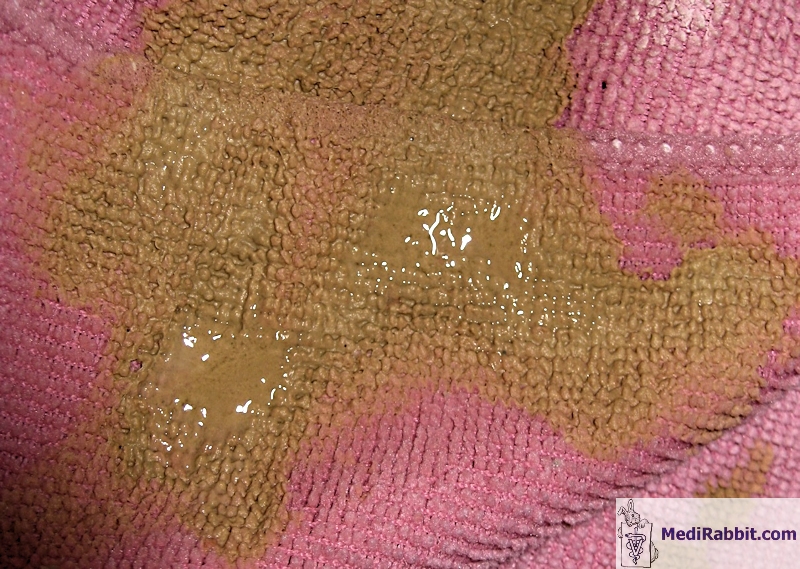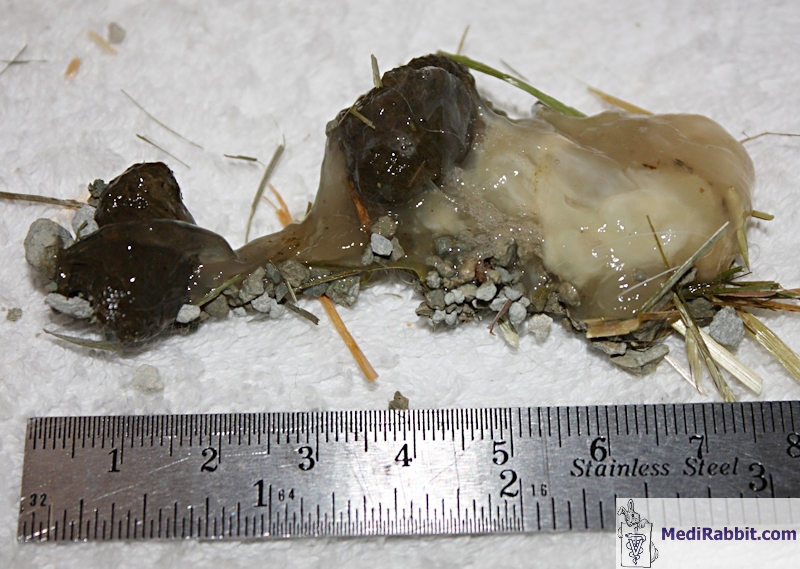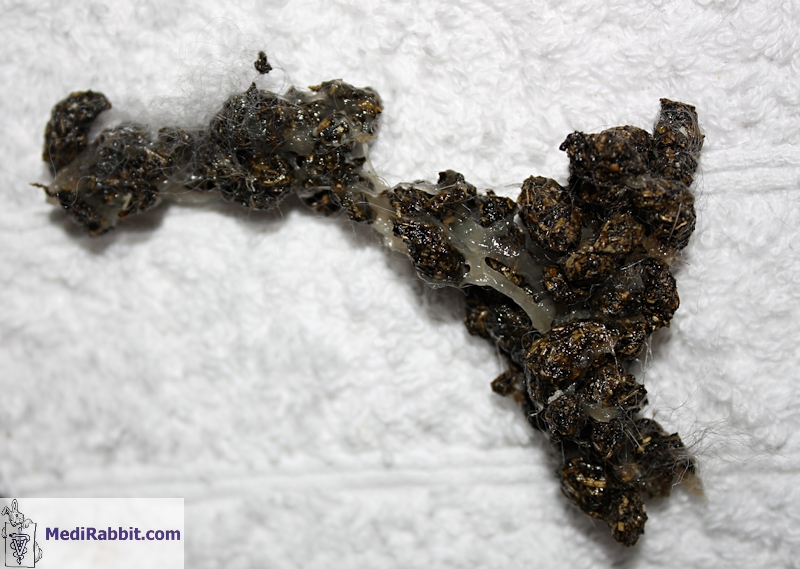Mucus among urine or rabbit feces
Possible
causes
Esther van
Praag, Ph.D.
|
MediRabbit.com is funded solely by the
generosity of donors. Every donation, no matter what
the size, is appreciated and will aid in the continuing research of medical
care and health of rabbits. Thank you
|
WARNING: this file
contains pictures that may be distressing for people.
|
When cleaning the environment in which
rabbits live, it is strongly advised to check the excrements, their shape,
quantity, size and color. The same is true of urine and other secretions. This
observation enables to detect the presence of unusual colors or mucus. In
normal times, rabbits produce two types of excrement: hard and round
droppings, and soft or caecotrophes. Hard droppings come from the intestines
and contain much fibrous material. A rabbit smells them, but rarely eats
them. Their color and size vary according to the diet. The more the diet
contains dry and fibrous matter, such as hay and straw, the larger the fecal
droppings will be, and have a brownish color. The more the rabbit eats fresh
food, salads and other carrots, the more the droppings tend to become smaller
and have a blackish color. The "fragrant" caecotrophes are formed
in the cecum. Each grain is covered with a thin layer of mucus. These
excrements are rich in vitamins, minerals, proteins, water and bacteria. In
order to avoid the nutrient loss, rabbits will reingest
these soft droppings directly from the anus and swallows them without
chewing. This avoids breaking the membrane surrounding the grains and allows
the continuation of the fermentation process as well as the survival of the
bacteria when they are in the hostile environment of the stomach. Sometimes,
the presence of mucus is observed among excrements. It can have a protective
and nurturing role. However, it can also be the sign of a malfunction. Protective
and nurturing mucus The reproductive tract of a female rabbit
has different internal organs, including the vagina and two uterine horns.
The lower part of each uterus forms the cervix that connects the vagina to
each uterine horn. The cervix possesses numerous glands that secrete mucus.
Their secretion is influenced by the reproductive hormones estrogen and
progesterone as well as by other hormones. The role of this mucus is
multiple. Its bactericidal properties protect the reproductive system of the female
rabbit against pathogens and, more particularly, the uterus in which the
pregnancy will take place. Its high pH ensures the survival of spermatozoa,
while its richness in mineral salts provides necessary energy to the spermatozoa
in order to continue their ascent in the reproductive system and fertilize
the ovules. Finally, the tight mesh of the different components of the mucus will
filter sperm, allowing the passage of well-formed gametes and eliminating
malformed ones. Once the ovules are fertilized, the secretion becomes acidic
again, coagulates and becomes opaque. Its expulsion is favored by the
vascularization of the uterus for pregnancy and allows the removal of dead
cells within the reproductive system of the doe. At this stage, the does
often turn her living place upside down, stirring straw and manure. This is a
sign that gestation has begun for the pregnant doe.
Mucus and
irritation of the urinary tract
Mucus is produced by specialized cells
lining the urinary tract. This substance migrates with the production of
urine and is used primarily to eliminate pathogens and prevent urinary tract
infections of the bladder and, sometimes, kidneys. It also allows to eliminate sediments and crystals contained in rabbit urine,
or small sized stones. In a healthy animal, the mucus is transparent and
usually very fluid. It is rarely visible except when urine is epressed from the bladder. It may then be observed as
filaments or as a "cloud". When the mucus present in the urine has
a yellowish and opaque color, it is a sign of disease. This affects both
males and females. In the latter, it may, furthermore, be caused by an infection
of the urinary or reproductive tract. Female rabbits are, indeed, more likely
to develop bladder infections than male rabbits because the bladder duct leading
urine outwards is shorter. Migration is shorter for bacteria, which favors
infections. The presence of mucus in the urine may also be the consequence of
mineral deposits in the bladder or kidneys. These deposits may be in the form
of "sand", resulting in a paste-like
urine, or in the form of stones. In rabbits, the formation of stones is unrelated
to the presence of calcium in the diet. An increase of the urinary pH in the
bladder will, however, favor the development of bacteria, which will excrete
waste (ammonium) and secrete a urease, enzyme capable of degrading urea. In
addition, an alkaline pH promotes the precipitation of magnesium, ammonium
and phosphate crystals, resulting in the formation of stones. The irritation
caused by "sand" or stones leads to the hypersecretion of mucus in
the urinary tract.
Mucus and
intestinal disorders
Mucus-producing cells are also found in the gastrointestinal
wall surrounding the lumen. They produce small amounts of mucus to protect tissues
and organs of the digestive system and reduce the damage caused by acids from
the stomach, certain foods or pathogen organisms. Indeed, the destruction of
the mucus layer represents a entry into the body via
the bloodstream. Mucus is clear and little visible or invisible in a healthy
animal. When a large amount of mucus is secreted, this is a sign of a
digestive problem. Any irritation of the mucosal layer and the lining of the digestive
tract will lead to an inflammatory process. The latter stimulates mucus secretory
cells, which start to excrete excessive amount of this substance to protect
the walls of the digestive system. The mucus has a yellowish, red or brownish
color. Large amounts of this substance among the droppings are often a sign
of slow peristaltic bowel movement, cramps, excessive gas or recent diarrhea.
Dehydration can also lead to excessive
intestinal mucus production.
Mucus and the presence of
parasites Different parasites colonize the digestive system of
rabbits. The most common are the protozoa responsible for coccidiosis or
giardiasis (rare nowadays) and various parasitic worms, the most common of
which is Passalurus sp. These parasites
colonize the intestine, the cecum and sometimes the liver in order to
reproduce. Their presence may be asymptomatic or may be accompanied by pain,
cramps, bloating, liquid diarrhea, apathy and/or unexplained weight loss. If
the worm population becomes excessive in the intestine, the mass of worms can
cause a painful blockage with massive mucus production. It is sometimes
possible to see white worms, live parasites, around the anus or in the
freshly evacuated solid fecals. Parasitic worms
should not be confused with the larvae (maggots) of flies, which are
parasites of the skin! Indeed, adult intestinal worms migrate to the anus to
lay eggs, causing itching. Their presence in the intestine or cecum causes
irritation of the mucous membranes and hypersecretion of mucus. Filaments of
clear or brownish (due to the presence of blood) mucus are often the only
clinical manifestation of intestinal parasites in rabbits. In case of giardasis other symptoms are noted.
Acknowledgements
Big great thanks to Michel Gruaz
(Switzerland), Luc Page (Switzerland), Paulette Foley (USA) and Sandy
Minshull (Canada) for the permission to use their pictures. |
e-mail: info@medirabbit.com







